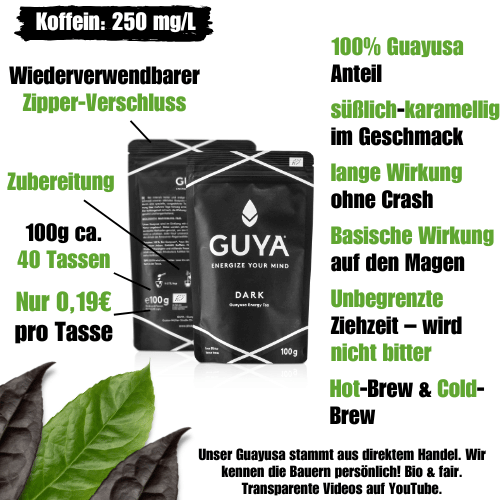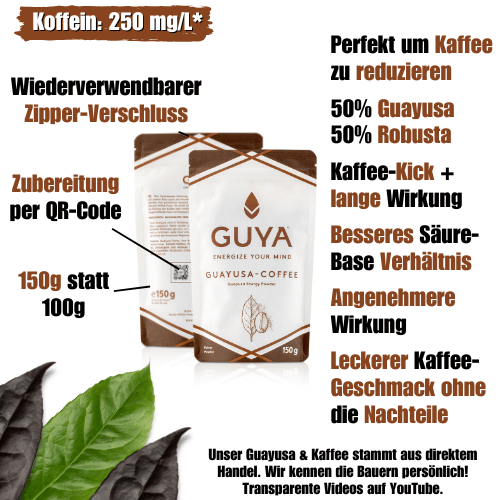Dopamine functions, sources, production and homeostasis

1 Introduction
Dopamine, an essential neurotransmitter and has correspondingly important functions in numerous body and brain functions. The regulation of dopamine production and the preservation of homeostasis-the natural balance of this messenger substance-is crucial for our well-being and our mental performance. However, unhealthy dopamine sources can interfere with this sensitive balance and lead to health problems.
In this article, we will deal with the mechanisms of dopamine production and function, identify unhealthy dopamine sources and discuss strategies to promote healthy dopamine homöostasis. Our focus is on sustainable changes in behavior and practical tips for a healthy, dopamine -rich start to the day. The aim is to re -program our natural reward system and align our brain on healthy rewards. Connect to us on this trip to the world of neurochemistry and learn how to control your dopamine level in a healthy and natural way.
Table of contents
1. Homeostasis
Homeostasis is a basic principle in biology And refers to the body's ability to maintain a stable inner state, despite constantly changing external conditions. It includes various systems and mechanisms that work closely together to protect this balance.
A prominent case of homeostasis in the human body is the nervous system. It plays a central role in the regulation and maintenance of various functions in the body. An important neurotransmitter involved in this regulation is dopamine. Dopamine has a crucial role in the control of the brain reward system, and its production and release is an excellent example of the use of the principle of homeostasis.
Another relevant example of homeostasis is the role of Interval. Intervall fasting, a diet in which diet breaks are taken regularly, leads to a series of metabolic adjustments to maintain energy high -homoostasis. During the fasting phases, the body pulls its energy from stored reserves to keep blood sugar levels constant. This process demonstrates the body's ability to adapt to changing circumstances and to preserve an internal balance.
2. Dopamine
Dopamine is an important neurotransmitter, a chemical messenger that transmits signals in the brain and in other parts of the nervous system. It has a wide range of functions in the body and is particularly involved in processes such as motivation, reward and movement.
2.1 Dopamine function
Dopamine plays a key role in the brain reward system. Every time we do something our brain feels worthwhile, dopamine is released. This leads to feelings of joy and satisfaction and motivates us to carry out this activity again. In addition, dopamine is essential for motor control and is involved in many functions, including memory and mood regulation.
2.2 Dopamin production
The production of dopamine takes place in certain regions of the brain, especially in a group of cells in the middle brain, which as Substantia nigra are known. Dopamine becomes from the Amino acid tyrosine manufactured that is absorbed from food. The process includes a number of biochemical reactions and is regulated by various enzymes and cofactors.
2.3 Dopamine sources
There are various ways of supporting dopamine production in the body. A healthy, balanced diet that is rich in certain nutrients can contribute to this. Food that are rich in tyrosine, such as almonds, bananas and avocados, can help promote dopamine production. In addition, certain lifestyle factors, such as regular physical activity And sufficient sleep, help to get healthy dopamine levels.
2.4 Concentration, focus, motivation
Dopamine is much more than just a "happiness hormone". It acts as a primary motivator and helps us to achieve a state of balance if it is available in sufficient quantities. With a healthy dopamine level we feel an increased drive, stressful situations can master more easily and our concentration and focus are increased. This can help us to better achieve our personal goals. Even how we get out of bed in the morning - both our physical willingness and our mood - depend on our dopamine level.
3.2 Prevent diseases
An imbalance in dopamine levels can lead to health problems. A lack of dopamine can, for example Parkinson's cause, a disease in which the muscles fail and can lead to symptoms such as twitches, cramps and, in the worst case, to the inability to move. On the other hand, an excessive dopamine level can schizophrenia and lead other mental illnesses.
3. What is unhealthy dopamine?
Our brain cannot always differentiate between positive and negative triggers for dopamine. Unfortunately, the reward system reacts to many factors, including sugar, drugs, food (especially fast food), television, computer games and social media. Although these things release dopamine and make us happy, they often lead to overstimulation of the nervous system through excessive dopamine release.
Excessive dopamine release through unhealthy habits can lead to a variety of problems.
- It can lead to the development of addictive behavior: Since dopamine is an essential part of the brain reward system, an excess of dopamine can be excessive. B. Sugar consumption or the use of social media is triggered to repeat these behaviors to experience the same "reward". These patterns can be difficult to break through and can lead to addictive behavior.
- Health problems: In the event of sugar consumption, this can lead to problems such as diabetes, weight gain and heart diseases. With excessive use of social media, this can lead to psychological problems such as anxiety, depression and sleep disorders.
- Constant overstimulation of the dopamine system can lead to an exhaustion of this system: Over time, this can lead to the brain reacting less sensitive to dopamine, which means that increasing stimuli are needed to achieve the same effect. Ultimately, this can lead to a reduction in the ability to draw joy and motivation from everyday activities.
3.1. Top 10 unhealthy dopamine causers
The following 10 reasons are particularly often responsible for an unhealthy committee of dopamine. You should either delete them entirely from your life or reduce them to an absolute minimum.
- Sugar and heavily processed food
- alcohol
- nicotine
- Excessive fast food consumption
- Illegal drugs (e.g. cocaine, amphetamines)
- Irregular sleep or lack of sleep
- Excessive media consumption (TV, computer games, social media)
- Lack of physical movement
- Excessive sugar consumption in drinks
- Certain drugs (e.g. some antidepressants and antipsychotics)
4. How to control dopamine
It is a common misunderstanding that the optimization of your dopamine level means to constantly increase it. On the contrary, it's about finding the right balance and maintaining a healthy homeostasis of your dopamine mirror. This can sometimes be a challenge, especially in a modern world full of potential "dopamine traps" such as fast food and excessive screen time.
With some conscious changes in life, however, you can learn to control your dopamine level in a healthy and sustainable way.
4.1 New programming of the reward system
The new adjustment of your reward system is a process that usually takes between 2 and 3 months. The aim is to balance the homeostasis between joy and reward. Accordingly, this phase is not about refraining from luxury foods or technical devices. Rather, the goal is to gradually reduce the consumption habits that lead to an unhealthy dopamine balance.
For example, take the consumption of snacks such as chips: Instead of consuming a bag every day, you can try to reduce consumption to every third evening, then after a few weeks on every fourth evening and so on until you can finally do without it. After completing this phase, you should be able to identify unhealthy dopamine sources and consciously consume if necessary, without falling back into old patterns.
4.2 Program new rewards
In parallel to reducing unhealthy dopamine sources, it is crucial to program your brain on new, healthy rewards. You should concentrate on activities that enrich your life. Ask yourself, yourself:
- "What deserves a reward?"
- "What goals do I pursue in life, today or this month?"
Here are some examples of activities that can promote healthy dopamine production. In our contribution to "More productivity and success in life“Let us also give you tips::
- Sporting activity
- Meet with friends
- Work on a personal project
- Cook
- Reading or listening to music
- Help the neighbor
These are just some examples. The key is to find activities that you not only enjoy, but also require a certain effort. In this way, your body learns to produce dopamine as an answer to productive and fulfilling activities and to preserve the homeostasis in your dopamine level.
5. Extra tips for a healthy dopamine start to the day
In order to start with energy and a healthy dopamine level in the morning, certain evening and morning routines are helpful. It is important to take into account the homeostasis, the central function of dopamine. An essential aspect is the timing of your meals. Try not to eat anything 2 to 4 hours before going to bed.
Before going to bed, you can adjust your reward system to healthy dopamine production by doing stretching exercises or light sports exercises. It is not about exhausting yourself, but about conditioning the brain on the dopamine distribution as a reward for effort. You could also read a non-fiction book to stimulate your brain with a healthy dopamine source.
After waking up, drink a glass of water and do light movement exercises. Before breakfast, you should get ready for the day to condition your brain on the fact that efforts before eating lead to a reward. These small activities can help you adjust your brain to even dopamine production during the day.
Avoid coffee in the morning because the quickly absorbed caffeine can cause an unhealthy dopamine kick similar to sugar. Replace coffee instead Guayusa, a natural product that supports your body with even and healthy dopamine production. More about the effect of Guayusa You can find out in our post “Guayusa Effect". However, if you don't want to do without the taste of coffee, we recommend it Guayusa-Tee coffee mix. Here you have a delicious coffee taste, paired with the special Guayusa-Effect.
5. Conclusion
A healthy dopamine level is crucial for our well -being, our productivity and the ability to meet the challenges of everyday life. Dopamine, an important component in the function of our brain cells, plays a crucial role in the reward reaction of our body, mood regulation and motivation.
However, it is important to understand that it is not just about producing more dopamine, but keeping homeostasis, i.e. the balance of this neurotransmitter. Excessive or unhealthy dopamine sources such as fast food, excessive screen use and sugar consumption can disturb dopamine production and lead to problems such as dependency and burnout.
The reprogramming of the reward system and the concentration on healthy dopamine sources can lead to improved dopamine production. This can be achieved by a conscious redesign of daily habits, for example through physical activity, healthy food, social interaction, setting and pursuing goals and avoiding unhealthy dopamine traps.
The morning start to the day can be optimized by taking the dopamine function into account, for example through movement exercises and changes such as replacing coffee Guayusa.
With these conscious and targeted changes, we can positively influence the role that dopamine plays in our lives, promote our homeostasis and lead a healthy, balanced and productive life.
FAQ
1. What is dopamine and what function does it have in the body?
Dopamine is a neurotransmitter, a chemical messenger that plays an important role in our nervous system. Among other things, it is responsible for the control of reward and motivation, emotional reactions, movement and numerous other functions.
2. What is homeostasis and why is it important for dopamine production?
Homeostasis is the balance or the stable condition that our body tries to keep. In the case of dopamine production, homeostasis refers to the maintenance of a healthy and balanced dopamine mirror, which is not too high and not too low.
3. What are unhealthy dopamine sources and how can you influence our body?
Unexpected dopamine sources are activities or substances that can cause excessive or uncontrolled dopamine release, such as excessive consumption of fast food, sugar, social media use or caffeine. They can lead to the disturbance of dopamine homöostasis and cause health problems such as addiction, difficulty concentration or sleep disorders.
4. How can I control my dopamine level and maintain healthy homeostasis?
By adapting your lifestyle, you can learn to control your dopamine level in a healthy way. This includes reducing unhealthy dopamine sources, programming the brain on new, healthy rewards, as well as the preserving of a balanced diet and sufficient movement.
5. What are some tips for a healthy, dopamine -rich start to the day?
Good night's sleep, sufficient hydration, morning movement and a balanced diet are important factors for a healthy, dopamine -rich start to the day. In addition, the conscious handling of technology and avoiding caffeine in the morning can help regulate your dopamine level and optimize your cognitive performance.























